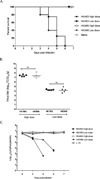Lymphopenia associated with highly virulent H5N1 virus infection due to plasmacytoid dendritic cell-mediated apoptosis of T cells
- PMID: 24829418
- PMCID: PMC4083746
- DOI: 10.4049/jimmunol.1302992
Lymphopenia associated with highly virulent H5N1 virus infection due to plasmacytoid dendritic cell-mediated apoptosis of T cells
Abstract
Although lymphopenia is a hallmark of severe infection with highly pathogenic H5N1 and the newly emerged H7N9 influenza viruses in humans, the mechanism(s) by which lethal H5N1 viruses cause lymphopenia in mammalian hosts remains poorly understood. Because influenza-specific T cell responses are initiated in the lung draining lymph nodes (LNs), and lymphocytes subsequently traffic to the lungs or peripheral circulation, we compared the immune responses in the lung draining LNs postinfection with a lethal A/HK/483/97 or nonlethal A/HK/486/97 (H5N1) virus in a mouse model. We found that lethal H5N1, but not nonlethal H5N1, virus infection in mice enhances Fas ligand (FasL) expression on plasmacytoid dendritic cells (pDCs), resulting in apoptosis of influenza-specific CD8(+) T cells via a Fas-FasL-mediated pathway. We also found that pDCs, but not other DC subsets, preferentially accumulate in the lung draining LNs of lethal H5N1 virus-infected mice, and that the induction of FasL expression on pDCs correlates with high levels of IL-12p40 monomer/homodimer in the lung draining LNs. Our data suggest that one of the mechanisms of lymphopenia associated with lethal H5N1 virus infection involves a deleterious role for pDCs.
Figures






References
-
- Subbarao K, Klimov A, Katz J, Regnery H, Lim W, Hall H, Perdue M, Swayne D, Bender C, Huang J, Hemphill M, Rowe T, Shaw M, Xu X, Fukuda K, Cox N. Characterization of an avian influenza A (H5N1) virus isolated from a child with a fatal respiratory illness. Science. 1998;279:393–396. - PubMed
-
- Chen Y, Liang W, Yang S, Wu N, Gao H, Sheng J, Yao H, Wo J, Fang Q, Cui D, Li Y, Yao X, Zhang Y, Wu H, Zheng S, Diao H, Xia S, Zhang Y, Chan KH, Tsoi HW, Teng JL, Song W, Wang P, Lau SY, Zheng M, Chan JF, To KK, Chen H, Li L, Yuen KY. Human infections with the emerging avian influenza A H7N9 virus from wet market poultry: clinical analysis and characterisation of viral genome. Lancet. 2013;381:1916–1925. - PMC - PubMed
Publication types
MeSH terms
Substances
Grants and funding
LinkOut - more resources
Full Text Sources
Other Literature Sources
Medical
Research Materials
Miscellaneous

